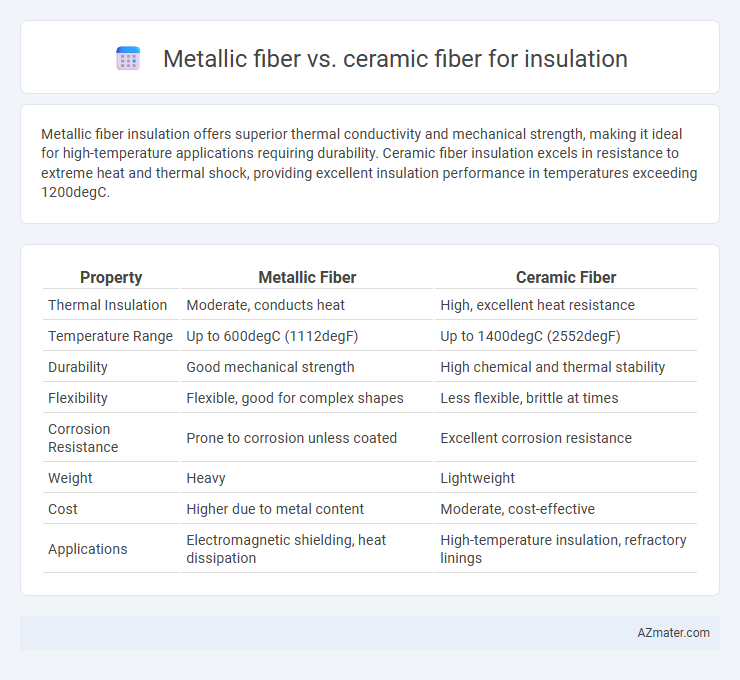Metallic fiber insulation offers superior thermal conductivity and mechanical strength, making it ideal for high-temperature applications requiring durability. Ceramic fiber insulation excels in resistance to extreme heat and thermal shock, providing excellent insulation performance in temperatures exceeding 1200degC.
Table of Comparison
| Property | Metallic Fiber | Ceramic Fiber |
|---|---|---|
| Thermal Insulation | Moderate, conducts heat | High, excellent heat resistance |
| Temperature Range | Up to 600degC (1112degF) | Up to 1400degC (2552degF) |
| Durability | Good mechanical strength | High chemical and thermal stability |
| Flexibility | Flexible, good for complex shapes | Less flexible, brittle at times |
| Corrosion Resistance | Prone to corrosion unless coated | Excellent corrosion resistance |
| Weight | Heavy | Lightweight |
| Cost | Higher due to metal content | Moderate, cost-effective |
| Applications | Electromagnetic shielding, heat dissipation | High-temperature insulation, refractory linings |
Introduction to Metallic and Ceramic Fiber Insulation
Metallic fiber insulation offers excellent thermal conductivity and durability, ideal for high-temperature industrial applications such as furnaces and heat exchangers. Ceramic fiber insulation provides superior heat resistance, low thermal conductivity, and excellent chemical stability, making it suitable for applications requiring high-temperature protection and energy efficiency. Both materials serve critical roles in insulation but differ significantly in thermal properties, mechanical strength, and chemical resistance.
Material Composition and Manufacturing Process
Metallic fiber insulation primarily consists of fine steel, aluminum, or copper fibers, known for their excellent thermal conductivity and durability, produced through processes like drawing, shredding, or electrospinning. Ceramic fiber insulation is made from alumina, silica, and other oxide-based materials, created by melting and spinning techniques to produce lightweight, heat-resistant fibers with low thermal conductivity. The distinct material compositions and manufacturing methods result in metallic fibers offering superior mechanical strength and electrical conductivity, while ceramic fibers provide enhanced thermal insulation and resistance to extreme temperatures.
Thermal Insulation Efficiency Comparison
Metallic fiber insulation offers superior thermal conductivity, making it ideal for applications requiring rapid heat dissipation and high-temperature resistance above 900degC. Ceramic fiber insulation excels in minimizing heat transfer due to its low thermal conductivity, maintaining efficiency in extreme environments up to 1400degC. Comparing thermal insulation efficiency, ceramic fibers outperform metallic fibers in reducing heat loss, while metallic fibers provide better thermal management when heat conduction is advantageous.
Temperature Resistance: Metallic vs Ceramic Fibers
Metallic fibers exhibit excellent temperature resistance typically up to 1,200degC (2,192degF), making them suitable for high-temperature insulation in environments such as industrial furnaces and aerospace applications. Ceramic fibers outperform metallic fibers with temperature resistance ranging from 1,300degC to 1,600degC (2,372degF to 2,912degF), offering superior thermal stability and insulation efficiency at extreme heat levels. The choice between metallic and ceramic fibers depends on the maximum operating temperature requirements and specific thermal conductivity needs of the insulation system.
Mechanical Strength and Durability
Metallic fiber insulation exhibits superior mechanical strength compared to ceramic fiber due to the inherent toughness and flexibility of metals, making it more resistant to impact and deformation under stress. Ceramic fiber, while excellent in thermal resistance, tends to be brittle and prone to cracking or fracturing under mechanical loads, limiting its durability in dynamic or high-vibration environments. For applications requiring long-term structural integrity and resilience against mechanical wear, metallic fiber insulation offers enhanced durability and stability over ceramic fiber alternatives.
Corrosion and Chemical Resistance Differences
Metallic fiber insulation offers superior corrosion resistance due to its inherent metal properties, making it ideal for environments exposed to moisture and harsh chemicals. Ceramic fibers demonstrate excellent chemical resistance against acidic and alkaline substances but are more susceptible to degradation in the presence of strong alkalis and chlorides. Selecting between metallic and ceramic fibers depends on the specific corrosive agents and operating temperatures in industrial insulation applications.
Weight and Flexibility Considerations
Metallic fibers used in insulation offer superior durability and higher temperature resistance but tend to be heavier compared to ceramic fibers, impacting overall system weight. Ceramic fibers provide excellent heat insulation with notably lower weight, enhancing ease of installation and reducing structural load. Flexibility is greater in ceramic fibers due to their lightweight and fibrous nature, whereas metallic fibers are relatively rigid and less adaptable to complex shapes.
Cost Analysis: Installation and Maintenance
Metallic fiber insulation generally incurs higher installation costs due to specialized handling and protective equipment requirements, whereas ceramic fiber offers more cost-effective and straightforward installation processes. Maintenance expenses for metallic fibers tend to be lower over time as they resist corrosion and degradation better than ceramic fibers, which may require more frequent replacement or repair in high-temperature or chemically aggressive environments. Evaluating total cost of ownership reveals that ceramic fiber provides initial savings, but metallic fiber may yield long-term economic benefits through reduced maintenance and enhanced durability.
Typical Applications in Industry
Metallic fibers are commonly used in high-temperature industrial applications such as heat shields, filtration systems, and electromagnetic interference (EMI) shielding due to their excellent thermal conductivity and durability. Ceramic fibers excel in insulation for furnaces, kilns, and power plants by providing superior heat resistance, low thermal conductivity, and chemical stability at temperatures exceeding 1,200degC. Industries like aerospace, automotive, and petrochemical often combine both materials to optimize energy efficiency and safety in extreme environments.
Environmental Impact and Safety Considerations
Metallic fibers offer superior thermal conductivity but pose environmental challenges due to their energy-intensive production and potential for metal particle pollution. Ceramic fibers provide excellent high-temperature resistance with lower environmental impact, being less energy-consuming and more inert, yet may release respirable fibers that require proper handling to prevent respiratory hazards. Both materials demand specific safety protocols to mitigate risks, with ceramic fibers necessitating respiratory protection and metallic fibers requiring measures against heavy metal exposure.

Infographic: Metallic fiber vs Ceramic fiber for Insulation
 azmater.com
azmater.com